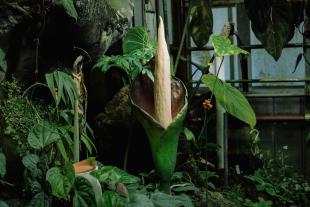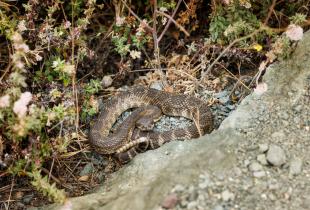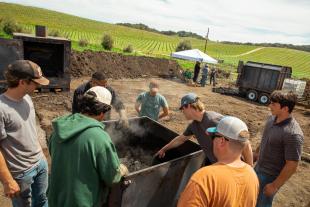Late Bloomer: Another Corpse Flower Comes to Life at Cal Poly's Plant Conservatory

This summer, for the second time in as many years, something unexpected happened at the Cal Poly Plant Conservatory.
One of the conservatory’s corpse plants bloomed. Even rarer? This one blossomed for the first time at nearly 18 years of age.
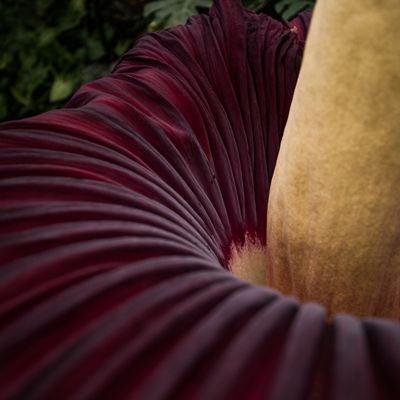
“It’s a late bloomer,” said biological sciences Professor Matt Ritter, the conservatory’s director. Ritter said he germinated the plant from a seed in the winter of 2003, when he first became a professor at Cal Poly. It was one of the first plants to grow in the conservatory.
The corpse plant that flowered last summer, dubbed Musty, was just six years old. The blooms also differed in size: this year, the plant’s flower was much bigger.
“It was probably about a foot taller than Musty and quite a bit wider,” said Gage Willey, the conservatory’s curator. “It was a pretty impressive flower.”
Willey said he noticed the plant start to shoot up through the soil on July 11th, and it grew quickly from there. The plant, which Ritter named Bertha in honor of Willey’s grandmother, who loved unusual plants, bloomed over the weekend of Aug. 7.
“It was maturing pretty quickly and just kept getting bigger,” Willey said. “It was pretty exciting to watch it grow.”
The corpse flower, also known as titan arum, Amorphophallus titanum, is native to the island of Sumatra. The plant makes the world’s largest unbranched inflorescence (cluster of flowers), but flowering is rare. The bloom can grow to more than 8 feet in height and over 3 feet in diameter.
When it flowers, the plant makes a huge stinky maroon funnel, called the spathe, with tiny flowers borne on a huge spike, which is called the spadix. The spathe sends a foul aroma into the still forest air for 24 hours to attract pollinators, then closes up.
When Musty bloomed last year, the conservatory was able to hold public viewings of the flower, which attracted thousands of people.
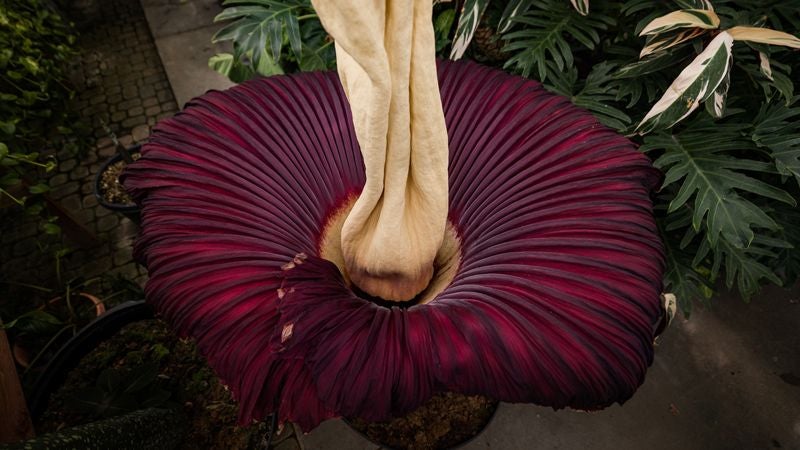
Unfortunately, due to scheduling conflicts and the speed of the bloom, many of the people who helped make last year’s corpse flower viewing event so successful weren’t available to host one this year. But Willey said having the bloom closed to the public allowed staff to collect more pollen than they would have been able to if it was on display.
“Because the pollen is in the base of the flower, it’s hard to extract. We removed that whole colorful skirt, the spathe, which usually you can’t do with a public showing,” Willey said. “Because of that we could put up an apparatus to collect pollen as it comes off the flowers, and we get to send off a lot more pollen to anyone interested in pollinating these plants.”
Willey said that they were able to collect “quite a bit” of ripe fruit from Musty’s flower last year that was sent off to universities and botanical gardens around the U.S. and as far away as Canada. They’re hoping to do the same with Bertha’s pollen.
“Hopefully, we’ll have some more Cal Poly corpse flower pollen out in the world,” Willey said.
As for future corpse flowers, Willey is hoping for another bloom once the new conservatory building opens up.
“It is really cool to bloom another one, and now I want to see how big they can get,” he said. “It would be awesome for the community to see another one up close and personal. It’s a nice way to hopefully inspire future generations of plant people. It’s one more opportunity to bring people and plants together.”
Don't want to miss any cool Cal Poly News stories? Sign up for our monthly newsletter, the Cal Poly News Recap!

